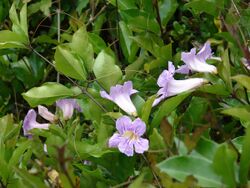Biology:Bignonia callistegioides
| Bignonia callistegioides | |
|---|---|

| |
| Scientific classification | |
| Kingdom: | Plantae |
| Clade: | Tracheophytes |
| Clade: | Angiosperms |
| Clade: | Eudicots |
| Clade: | Asterids |
| Order: | Lamiales |
| Family: | Bignoniaceae |
| Genus: | Bignonia |
| Species: | B. callistegioides
|
| Binomial name | |
| Bignonia callistegioides Cham., 1832
| |
| Synonyms[1] | |
|
Clytostoma callistegioides (Cham.) Bureau ex Griseb. | |
Bignonia callistegioides, also known as violet trumpet vine and lavender trumpet vine, is a vine native to southern Brazil and Argentina .[2]
Description
It is a moderately fast growing, woody, evergreen perennial vine that reaches a height of 6 to 15 metres (20 to 50 feet), where it features bifoliate, hairless green leaves with tendrils.[2]
It's tubular flowers are lavender to lilac blue which are borne from spring to summer. They feature a white to yellow throat with conspicuous floral violet veins. The fruit is a brown capsule that produces winged seeds.[2]
Cultivation
It is a heat-loving, frost tolerant plant that is grown as a ornamental plant on trellises, arbors, pergolas, wall covers or as a sprawling groundcover.[2] It can be growing from stem cuttings or tip layering.[3]
References
- ↑ Clytostoma callistegioides (Cham.) Bureau ex Griseb. by PlantNET. Retrieved 5 February 2022.
- ↑ 2.0 2.1 2.2 2.3 Clytostoma callistegioides (Synonym: Bignonia callistegioides) Virtual Library of Phoenix Landscape Plants. Retrieved 5 February 2022.
- ↑ Growing Bignonia callistegioides: Lavender Trumpet Vine GardenOracle. Retrieved 5 February 2022.
Wikidata ☰ Q15545682 entry
 |


